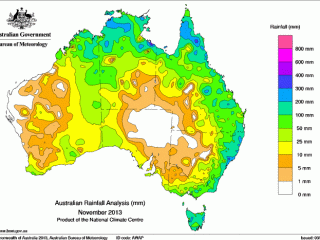 Rain gauges across large parts of Northern Australia have been earning their keep in recent weeks, some local creeks have been flowing again and the occasional Land Cruiser has been getting bogged, signs of an early and very welcome start to the wet season.
Rain gauges across large parts of Northern Australia have been earning their keep in recent weeks, some local creeks have been flowing again and the occasional Land Cruiser has been getting bogged, signs of an early and very welcome start to the wet season.
While more storms are needed before a good wet season can be declared, early falls totaling 50-100mm in various parts have put a spring in the step of many producers following an extremely dry year.
Where rain has fallen the country has greened up, the cattle have turned a corner condition wise, coming at a time of additional orders to Indonesia and higher prices for export cattle than has been seen all year.
Availability of surface water remains a very serious issue even where good rain has fallen, as in most cases storms have hit ground so parched that run-off has been inadequate to lay surface water, further underlining the need for follow-up rain.
Recorded totals have again been patchy but in areas such as Top End, around Katherine and north of the Carpentaria Highway there have been reports of good rain.
Some of the dry areas of north western Queensland have also seen decent rain in recent weeks, with areas such as Richmond recording around 50mm and Julia Creek and Cloncurray recording 25-75mm.
“It’s been patchy but at the same time it is filling in a lot of the blanks, most people should have got something,” Luke Westaway at TopX Richmond said.
“It is early in the scheme of things, November rain is a big bonus. It was needed and it has been a bonus to have got it now.”
Australian Agricultural Company operations manager Troy Setter said most of the company’s stations have received a good start to the wet season after one of the driest years on record.
Totals recorded by AA Co stations to date include 300mm at Tipperary Station south of Darwin; over 200mm on the Victoria River Downs stations of Delamere, Montejinni and Camfield, as well as south west of Katherine; 50-100mm on the Barkly stations of Anthony Lagoon, Brunette Downs, Avon Downs and Headingly, and the same amount in the Gulf stations of Canobie, Dalgonally and Carrum.
The company’s properties in Central Queensland have received 100-150mm, while South Galway in the Channel Country remains dry.
“Apart from western and southern Queensland we are off to a good start, however the soil profile is so dry it will take a good wet season for the grass to recover,” Mr Setter said.
The Thamas Pastoral Company owned Tanumbirini on the western edge of the Barkly Tableland has measured 60mm in the rain gauge since October, but the there are signs that large areas of the 526,000 hectare (1.3 million acre) station have received more.
Thames Pastoral Company general manager David Connolly said that after a tough 15 months season and price wise, it was exciting to see both improving at the same time.
“It has been a wonderful start to the season, and it is has given people confidence.
“If we can combine a good season with good prices for a change, it will give the property market confidence, all sorts of things will change around.
“Certainly there has been some good orders and some good uptake of cattle into this end of the year, and for the next couple of months at least into next year there are some solid orders as well.”
After being battered from pillar to post by seasons and prices in recent years, Mr Connolly said the smiles were returning.
“A bit of rain, and a good outlook of being able to sell some cattle if you’ve got them ready, it has really put a spring back in the step of a lot of pastoralists,” Mr Connolly said.
“It is amazing how cockies can keep getting blow after blow, but it just doesn’t take much to put a spring back in their step.”
Rain eases supply pressure on market
Meat & Livestock Australia said the early break has helped to alleviate some pressure on northern cattle markets, with supply easing 32pc month-on-month across NLRS reported Queensland markets during November.
At the same time average Queensland yearling steer prices lifted by 4c on the previous month to 178c/kg lwt, while heavy steers gained 5c to 187c/kg lwt, and cows improved by 8c, to average 128c/kg lwt.
Western Australian experienced good falls during November in the east of the state, while the central regions and west coast ranged from ‘average’ to ‘below average’.
Rainfall in November in New South Wales saw ‘above average’ falls limited to the coastal regions, while inland falls ranged from ‘average’ to ‘very much below average’.
However Weatherzone reported that some decent falls were recorded across New South Wales on Wednesday night, with a low pressure trough and front bringing the heaviest 24 hour falls to some areas in more than a decade.
Falls were generally heaviest along the ranges and southern parts of the state. Deniliquin in the far southwest received 45.6mm, its heaviest 24 hour December rain since at least 1997.
Widespread totals of between 20-70mm fell across the NSW/VIC border, while further north between 10-20mm fell along and just west of the ranges.
Albury received 29mm, its heaviest fall since September and the heaviest for December in eight years.
Click on map below to view in larger format
